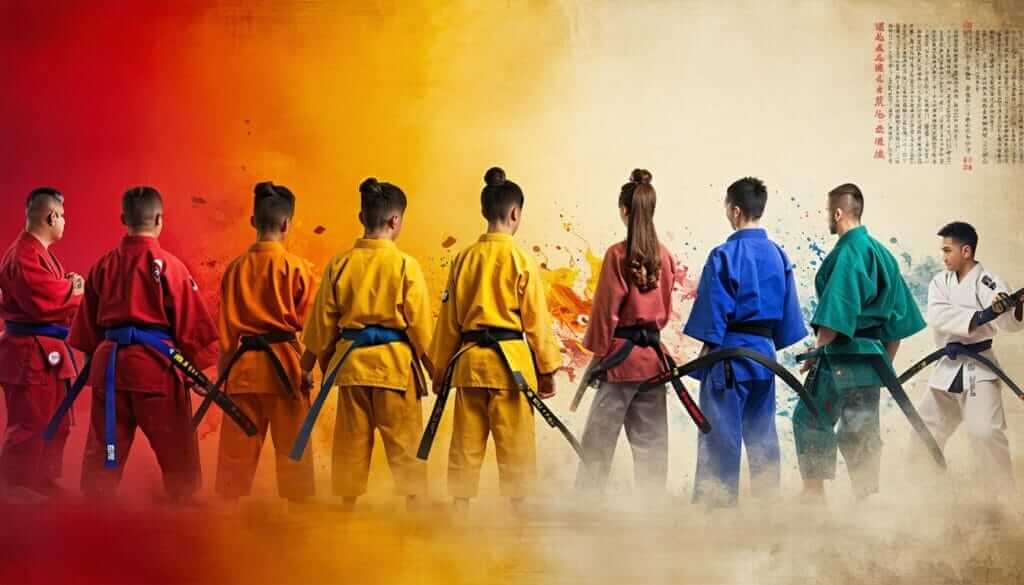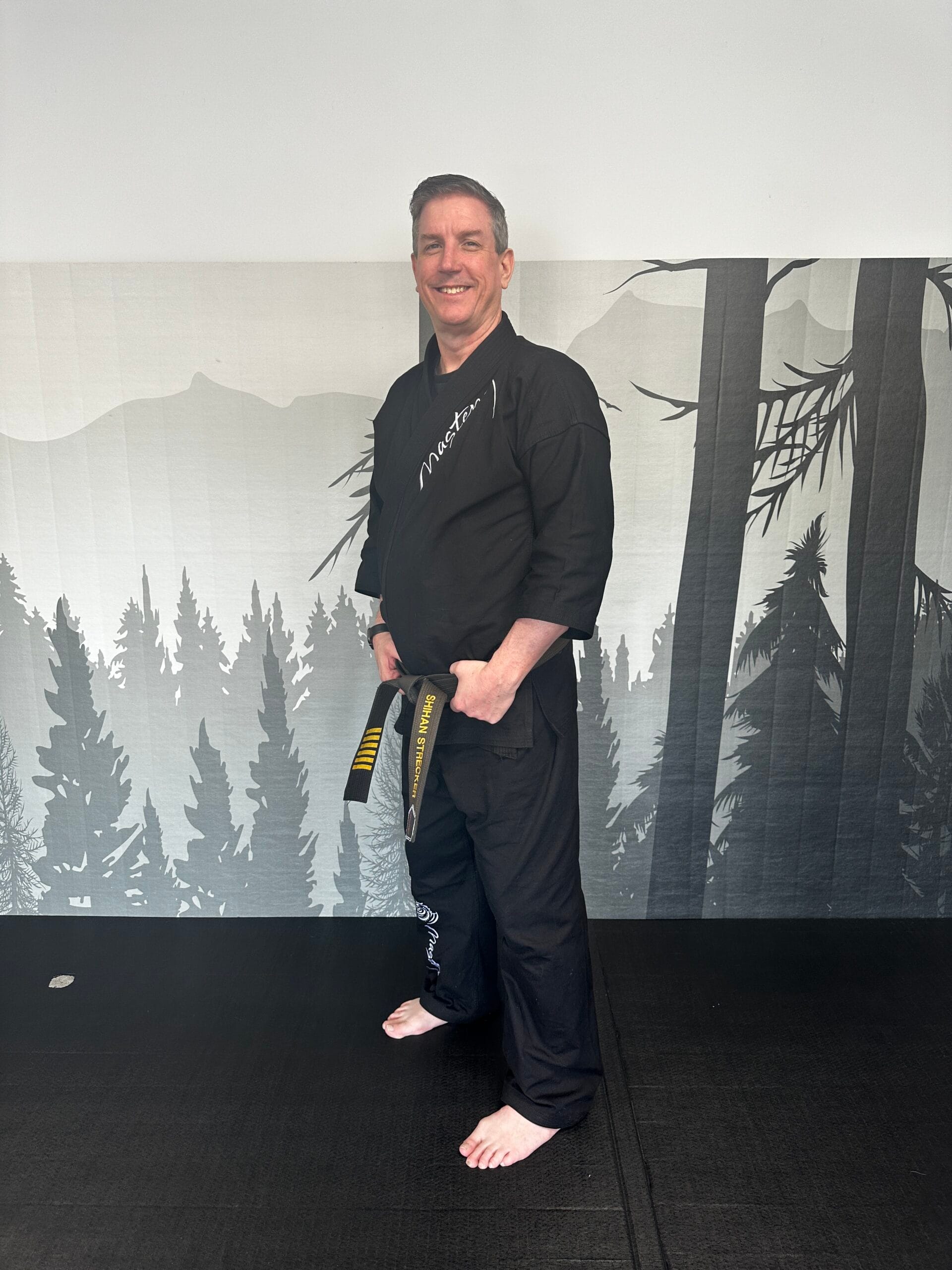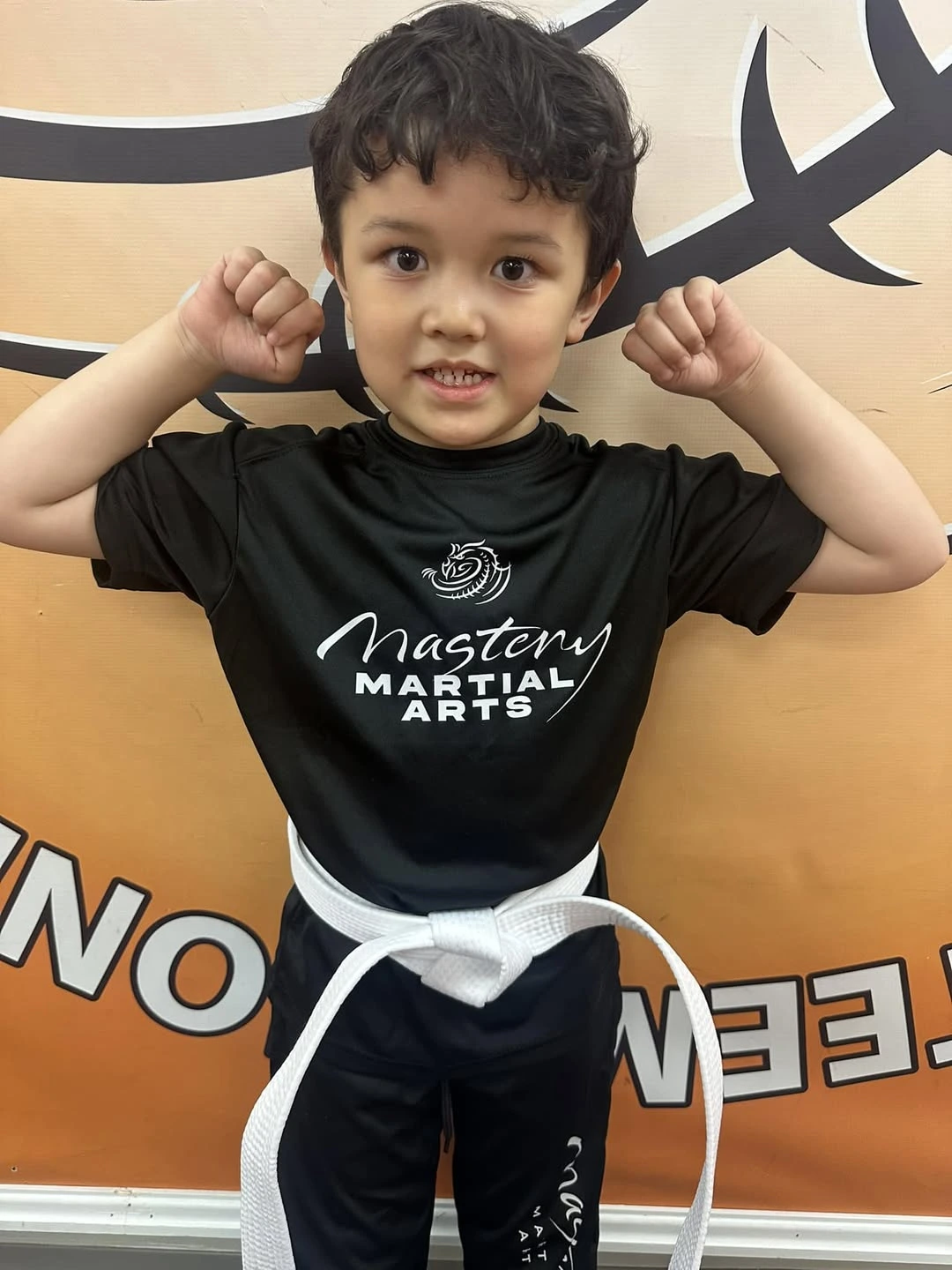Evolution of Belt Ranking
The belt ranking system in martial arts carries a fascinating history, showing how folks in the fighting arts are acknowledged for their skills and achievements.
Inception of Ranking Systems
It all kicked off back in the 19th century. But, way before belts were even a thing, Japan was using a system called Menkyo (免許) in the 8th century. This old method involved masters handing out certificates to recognize student progress instead of using belts for this (Premier Martial Arts).
Fast forward to 1883, Kanō Jigorō—the brain behind Judo—came up with the first belt-based ranking system. This was the dan system, splitting learners into beginners (kyu) and advanced (dan) categories. The system gave us the iconic black belts for advanced levels and white belts for the novices—marking a big change in recognizing martial arts prowess.
| Year | Event |
|---|---|
| 8th Century | Start of the Menkyo (免許) system in Japan |
| 1883 | Kanō Jigorō comes up with the first belt ranking, featuring black and white belts. |
Spread of Colored Belts
The leap from just black and white belts to a rainbow of colors can be credited to Mikinosuke Kawaishi. In 1936, after making his way to France, Kawaishi introduced a color system that gave students a visual cue of where they stood in their journey to the coveted black belt (Kicksite).
This change added more layers of understanding to a student’s skill set, syncing up with various martial arts like Taekwondo and Judo. It wasn’t until 1956, though, that the kyu/dan system got its worldwide approval, thanks to the Okinawa Karate Federation. This move glued the belt ranking firmly into the martial arts world.
| Year | Event |
|---|---|
| 1936 | Kawaishi brings colored belts to France. |
| 1956 | Okinawa Karate Federation makes the kyu/dan system official. |
By stitching the belt ranking system into different martial arts styles, it became a steadfast part of martial culture worldwide. It underscores the system’s flexibility and meaningfulness. For a deeper dive, check out our pieces on martial arts belt ranking history and martial arts belt ranking traditions.
Historical Significance
Origins of the Belt System
You know how candy comes in all sorts of colors? Well, turns out, belts in martial arts follow the same idea, except instead of yumminess, they symbolize how far you’ve come in your training. Back in the late 1800s, Kanō Jigorō, the genius behind Judo, cooked up the belt ranking concept. In 1883, he came up with a straightforward system: kyu for beginners (cue white belts) and dan for those rocking the advanced moves (cue black belts) (Premier Martial Arts).
This simple color coding set the stage and tinkering turned into an entire rainbow across different martial arts. As karate, taekwondo, and other styles spread, more colors joined the belt brigade to represent progress. Look below to see how you can climb from rookie to pro in the world of martial arts:
| Rank | Belt Color |
|---|---|
| 1st | White |
| 2nd | Yellow |
| 3rd | Orange |
| 4th | Green |
| 5th | Blue |
| 6th | Brown |
| 7th | Black (1st Dan) |
Kanō Jigorō’s Contribution
Kanō Jigorō is pretty much a rockstar in martial arts circles. His system didn’t just give structure—it added that sprinkle of excitement by letting folks chase colors as they got better. So, instead of just throwing punches and kicks, the color twist meant both teachers and students could see progress, like leveling up in a video game but with more sweating involved (Premier Martial Arts).
Kanō’s nifty idea wasn’t just limited to judo. As martial arts went global, it became the norm across disciplines like karate, taekwondo, and Brazilian Jiu-Jitsu. Thanks to those colored belts, folks were more engaged, earning each stripe with blood, sweat, and maybe a tear or two. It’s still the backbone of martial arts training today.
Want to geek out more on how belts make the magic happen in different styles? Dive into the tales of the martial arts belt ranking history and peek into belt ranks in karate history.
Symbolism of Belt Colors
Martial arts belts aren’t just pretty colors; they’re packed with meaning, showing how far students have come on their personal journey. Each belt isn’t just a fashion accessory; it’s a badge of growth, showing skill levels and dedication.
White and Black Belts
Think of the white belt like an empty slate—it’s clean, fresh, and brimming with new potential. It’s where all martial artists kick off their path, a fresh start full of promise. As they move forward, they typically hit the yellow belt, symbolizing those crucial strides in learning. With each new belt, like orange, the student takes in more knowledge. Green stands for a rock-solid base, firmly rooting the learner.
Now, the black belt? That’s the big cheese! It’s a blend of hard work, learning, and just a sprinkle of sweat. But here’s the catch—it’s not just about reaching a peak; it’s like walking through one door and finding you’re in a whole new room of challenges. Traditions color these belts differently too. In Japan, a white belt can mean you’re letting go of your old habits, getting the mind ready for martial arts. On the flip side, the black belt is like hitting the refresh button on your life, diving deep into the art form (Century Martial Arts).
| Belt Color | What’s It Mean |
|---|---|
| White | Fresh start, full of promise |
| Yellow | Off to a promising start |
| Orange | Learning more, expanding horizons |
| Green | Building that solid base |
| Blue | Handling the tough stuff |
| Purple | Almost at the top – black is close! |
| Brown | Prepped for the next big step |
| Black | Mastery in one hand, new start in the other |
Interpretations Across Cultures
Different strokes for different folks—or in this case, different interpretations. Martial arts schools from different cultures give belt colors their unique spins. Koreans, for example, treat that white belt as the start of everything, with black being the end of a cycle. In between, each belt shows important steps along the learning path. Despite the differences in schools, you’ll often find common ideas like:
- White: The start and that clean slate feel
- Yellow: The “here we go!” moment
- Orange: Moving up and reaching out
- Green: Laying down the framework
- Blue: Taming the tricky stuff
- Purple: Heading toward that black belt
- Brown: All geared up for new challenges
- Red: Mastering self-discipline
- Black: Everything learned comes together and the teaching begins (Kicksite, Master S.H. Yu Martial Arts).
These belts aren’t just markers on a journey; they’re philosophical nuggets sprinkled throughout martial arts. Knowing why each belt color matters adds more than just a splash of color—it boosts appreciation for martial arts and the mountain of commitment behind every step up. To dive more into how belt rankings work, peek at our section about martial arts belt ranking traditions.
Progression and Mastery
Grasping the ins and outs of martial arts belt ranks is crucial for anyone wanting to build up their skills and knowledge in an organized way. Each step up the belt ladder shows not just more skill, but also a stronger commitment to the art.
Climbing the Belt Ladder
Martial arts newbies start at the bottom and work their way through the rainbow of colored belts until they hit the black belt jackpot. In this climb, beginners deal with several ranks, called kyu, before moving on to the Dan levels which mark advanced mastery. The nitty-gritty for moving up can be quite different depending on martial arts styles.
Take karate, for example. Students need to strut their stuff in three areas: technique (kihon), form (kata), and sparring (kumite). Usually, students face a belt test every three months, and it often takes at least three years of dedication to nab that coveted first black belt (1st Dan) source.
| Rank Level | Usual Time (Years) | Kyu/Dan Level |
|---|---|---|
| Beginner to 1st Kyu | 1 – 3 | Kyu |
| 1st Dan (Black Belt) | 3 – 5 | Dan |
| 2nd Dan | 1 | Dan |
| 3rd Dan | 2 | Dan |
| 4th Dan | 3 | Dan |
| 5th Dan | 5 | Dan |
| 6th – 9th Dan | 10+ | Dan |
| 10th Dan | Lifetime | Dan |
The International Martial Arts Federation lays out ten steps in the Dan ranking, where hitting the tenth level could take your whole life, showing major dedication Century Martial Arts.
The Honor of Black Belts
Getting a black belt isn’t just a symbol of kicking butt; it stands for deep skills and a real passion for the art’s core values and philosophy. Each Dan level after that black belt digs deeper into what the martial arts are all about, like humility, integrity, and commitment.
Some systems might take more than 20 solid years of training to reach the 5th Dan. Climbing up to that 9th Dan black belt can be a 40-year adventure, making it a monumental feat that screams lifetime devotion source.
On this never-ending belt journey, many pick up teaching skills and end up as leaders in their martial arts circles. Want to learn more about what all those belt colors mean? Check out our article on martial arts belt colors meaning. Knowing how ranks climb gives a respectful nod to the long history and meaning of this martial arts trip.
Mastery and Leadership
Mastery Beyond Black Belt
Getting black belt in martial arts? Big deal. It’s like finding the ‘Welcome’ sign when you walk into Disneyland. You’re not done, you’re just getting started! The International Martial Arts Federation recognizes this by having ten whole levels in the Dan ranking system. You’re embarking on a lifetime adventure, possibly battling for that elusive tenth-degree black belt like a superhero in a never-ending saga. It ain’t easy, but neither is being a hero.
Let’s talk time. Reaching that 5th Dan? You’re looking at sacrificing over 20 years, and that eye-watering 9th Dan could chew through more than 40 years of your life. Each level screams dedication, crazy skills, and a side helping of humility, akin to the patience of dealing with a hundred toddlers on a sugar high.
| Dan Level | Years Required |
|---|---|
| 1st Dan (Black Belt) | 1-3 years |
| 5th Dan | 20+ years |
| 9th Dan | 40+ years |
Role as an Instructor
After you’ve snagged your black belt, there’s a new gig waiting—Instructor times. Not about the paycheck, but the inner glow from growing the next batch of martial artists. You’re not just dishing out punches and kicks; you’re serving life values with a side of discipline and respect.
An instructor isn’t just there to shout and count. They guide dojo newcomers like a GPS that sometimes smacks you on the head if you take a wrong turn. They’re the moral compass, keeping everyone aligned with the rite of passage each belt level offers. Whether students are getting down with sparring or deepening their understanding of martial arts, the instructor is the Bedrock Bub, the dependable Flintstone of the dojo.
With a black belt around the waist, you become not just a role model but almost a mythical figure for students—an inspiring mix of grit, compassion, and all those superhero credits. You’re prepping your crew to move up the ranks, echoing values you’ve learned. Mastery in martial arts isn’t just about personal scorekeeping; it’s about kindling that martial magic in others. Want to dig more into how belts have their own historic flair? Check out our belt ranking history page.
Belt Ranking Across Arts
Martial arts keeps us on our toes with its many ways of ranking belts. Each one tells an old story of progress and change. Look at Taekwondo, Karate, Judo, and Brazilian Jiu-Jitsu for a snapshot of how things work.
Taekwondo and Karate
Taekwondo and Karate have their own belt systems that show how far you’ve come and how good you’ve gotten.
Taekwondo Belt Rankings
Taekwondo starts you off with white, then you climb through a rainbow of colors until you hit black. The climb looks like this:
| Belt Color | Order |
|---|---|
| White | 1st |
| Yellow | 2nd |
| Orange | 3rd |
| Green | 4th |
| Blue | 5th |
| Brown | 6th |
| Black | 1st Dan |
Black belts in Taekwondo can keep getting more gold stripes as they get better. It’s all about keeping up the hard work and never stopping to learn.
Check out more on this in our tale about belt ranks in taekwondo history.
Karate Belt Rankings
Karate follows the lead set by Dr. Jigoro Kano. It’s one of the first to use colors for ranks. You kick off with white and move through a few steps before you hit black (1st dan). Here’s how it goes:
| Belt Color | Order |
|---|---|
| White | 1st |
| Orange | 2nd |
| Red | 3rd |
| Yellow | 4th |
| Green | 5th |
| Purple | 6th |
| Brown | 7th |
| Black | 1st Dan |
Usually, it takes three to five years of serious practice to get a black belt. The Karate Union of Great Britain is pretty strict—each dan rank needs a minimum of three years. Styles like Shotokan and Wado-Ryu may mix up the colors or orders a bit. For more on this, read our story on belt ranks in karate history.
Judo and Brazilian Jiu-Jitsu
Judo’s belt game is similar to Karate. You start with white and work toward black, showing your skill and growth.
Brazilian Jiu-Jitsu takes its own path, slightly twisting the traditional way. Here’s the scoop:
| Belt Color | Order |
|---|---|
| White | 1st |
| Blue | 2nd |
| Purple | 3rd |
| Brown | 4th |
| Black | 1st Dan |
In BJJ, it’s all about perfecting your moves and tactics at every stage before moving up the ladder.
Getting these systems down gives you a glimpse into the deep roots and ideas that shape martial arts belt ranking. Each style and tradition colors our martial arts world, making it as varied as it is rich.




